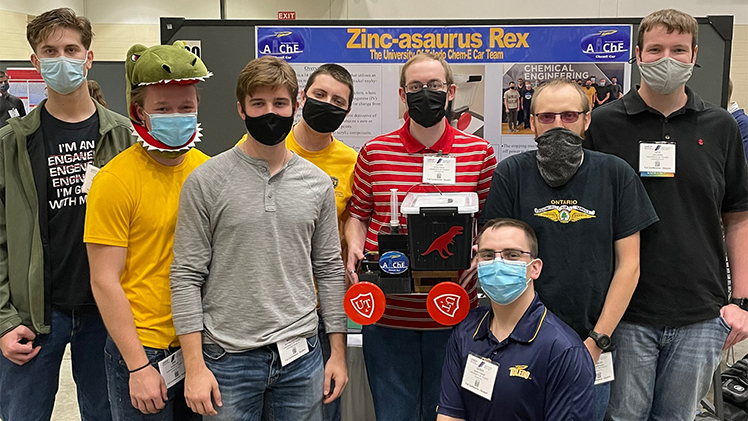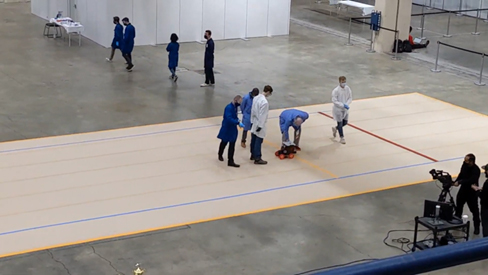The University of Toledo Chem-E Car Team recently took first place in the 2021 American Institute of Chemical Engineers (AIChE) Annual Student Conference Chem-E Car Competition in Boston, competing against more than 20 universities worldwide.
The target distance during the competition was 21.05 meters, and their chem-e car, named Zinc-asaurus Rex because it’s propelled forward by a homemade zinc nickel oxyhydroxide alkaline battery, stopped just 10 centimeters from the target distance to seize the victory in the international chem-e car competition.

From left are members of UToledo’s chem-e car team: Nicholas Trumbull, Asa Killam, Brayden Holloway, Jonathan Bonkoski, Kevin Fruth, Derek Etzler (kneeling), Charles Wade and Levi Jones.
The team also received the safety award for having the chem-e car with the most inherently safe design and best application of the principles of chemical process safety.
“Our victory was the perfect way to cap off my last semester serving as chem-e car team captain,” said Kevin Fruth, a senior chemical engineering student graduating in December and 2021 AIChE chem-e car team co-captain alongside Jonathan Bonkoski, a junior chemical engineering student.
“And it was the culmination of hundreds of hours of preparation in the laboratory, technical expertise fostered during co-op rotations and extensive knowledge obtained from my chemical engineering faculty and courses.”
The goal of the chem-e car competition is to create a shoebox-sized car powered by a chemical reaction that will travel a target distance and stop accurately by a chemical reaction.
While the zinc and nickel oxyhydroxide alkaline battery is the propulsion mechanism for Zinc-asaurus Rex, the chem-e car utilizes a chemical chameleon reaction — an oxidation reduction reaction between sucrose and potassium permanganate — as its stopping mechanism.
As the chameleon reaction progresses, the solution changes from purple to amber. A small microcontroller called an Arduino collects the red color values of the solution and calculates the first derivative of red color values, and is programmed to stop the car when the first derivative of the red color equals zero or negative for three of the last five values.

Nicholas Trumbull waits to pick up the car after it stopped 10 centimeters from the 21.05 meters finish line on the second run.
One hour before the competition, the target distance of 21.05 meters was announced, meaning all teams had 60 minutes to determine the appropriate amount of chemical reagents to stop their chem-e car at the target distance based on their car’s velocity and previous chemical reaction stopping mechanism calibration curves.
During the competition, all teams were given two opportunities to stop their car as close to the target distance as possible, and their final score was based on the closest run of the two.
On UToledo’s first run, Zinc-asaurus Rex stopped 18 centimeters short of the target distance. To stop closer to the target distance on their second run, the team slightly decreased the amount of sucrose added to the chameleon reaction to increase the reaction time and travel farther before stopping. The sucrose adjustment was successful on their second run: Zinc-asaurus Rex stopped just 10 centimeters from the target distance to seize victory.
The second place through fifth place teams were Virginia Tech (23 centimeters), University of North Alabama (27 centimeters), University of Arkansas (30 centimeters), and Iowa State University (54 centimeters).
Fruth said the chem-e car’s victory was the result of extensive preparation by the team’s 13 undergraduate interdisciplinary engineering student members who built zinc nickel oxyhydroxide batteries and performed chemical chameleon reaction calibration tests in the Unit Operations Laboratory throughout spring and fall semesters.
“Our team’s success would not have been possible without the resources and experiences available to students enrolled in The University of Toledo College of Engineering.”